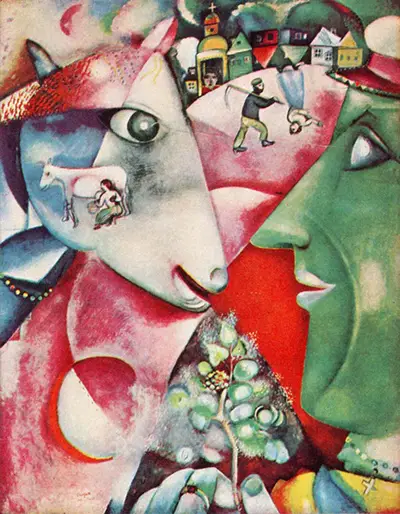A man with a green face and wearing a cap jovially encounters a goat, or is it a sheep? On the cheek of the animal is a picture of a goat being milked.
In the background, a man walks down a traditional Russian street with a scythe over his shoulder, while an upside down woman plays the violin. In the foreground, the green-faced man’s hand holds an illuminated tree. Round his neck is a Christian cross.
It appears that in this village peasants and animals live side by side. The man and the animal regard each other with trust in what seems to a mutually beneficial relationship.
The illuminated tree of life the man holds is perhaps the reward for their relationship. Animals connect us with the universe.
The artist does not comment on the extraordinary collage of images he has assembled in any way. He offers it as a gateway into the world of a Hassidic child growing up in a small rural settlement.
In I and the Village Chagall mixes modern and figurative elements with cheerful indifference to convention, perspective and the forces of gravity. His playful use of humour, colour and emotion foreshadows the style that would lead to him becoming world famous and exerting enormous influence on subsequent artists.
Marc Chagall was born in 1887. He was the eldest of seven children. He grew up in the small town of Liozna, near Vitebsk. The settlement was home to a large community of Hassidic Jews. He went to a Jewish school. During this early education, he absorbed the images and mythology of Judaism that would feature so strongly in his work.
While at school he spent perhaps too much time copying pictures from books. He loved doing this so much and demonstrated such a talent that he decided to become an artist. His parents were not happy about this but Chagall was not to be moved.
In 1906 he went to a small local art school. After a few months, he moved on to the Zvantsea School of Drawing and Painting in St Petersburg. While there he worked with Leon Bakst, a devout Jew, who was a set designer for Diaghilev’s Ballets Russes. It is thought that Bakst suggested Chagall use the Jewish folk imagery which was to feature so strongly in his work.
After spending three years in the cosmopolitan atmosphere of St Petersburg he moved on to Paris.
When he arrived in Paris in 1910, at the age of 23, and unable to speak French, he joined a small art academy. There he was immediately drawn to the energy of the Cubist and Fauvist compositional styles. The abstract nature of these styles freed his imagination so that he could create a vocabulary of images that would depict his inner life with a directness that led to his huge success.
Chagall rejected the academic formalism that characterised a lot of Cubism. He moved away from intellectual analysis. What he brought to the work was playfulness and a deep sense of myth. His canvases are fairy tales firmly rooted in Russian Jewish life. The images in I and the Village do not invite analysis. They are an invitation to join the party.
I and the Village combined Russian and Yiddish and Christian folk images in a way that was groundbreaking. The energy and humour of the composition combined with the reverberation of the content created a world that was new.
Chagall made fairy tales out of the modern and shaped them with his own specific imagination.
I and the Village invites the viewer to share in a world filled with joy and myth and mystery.
